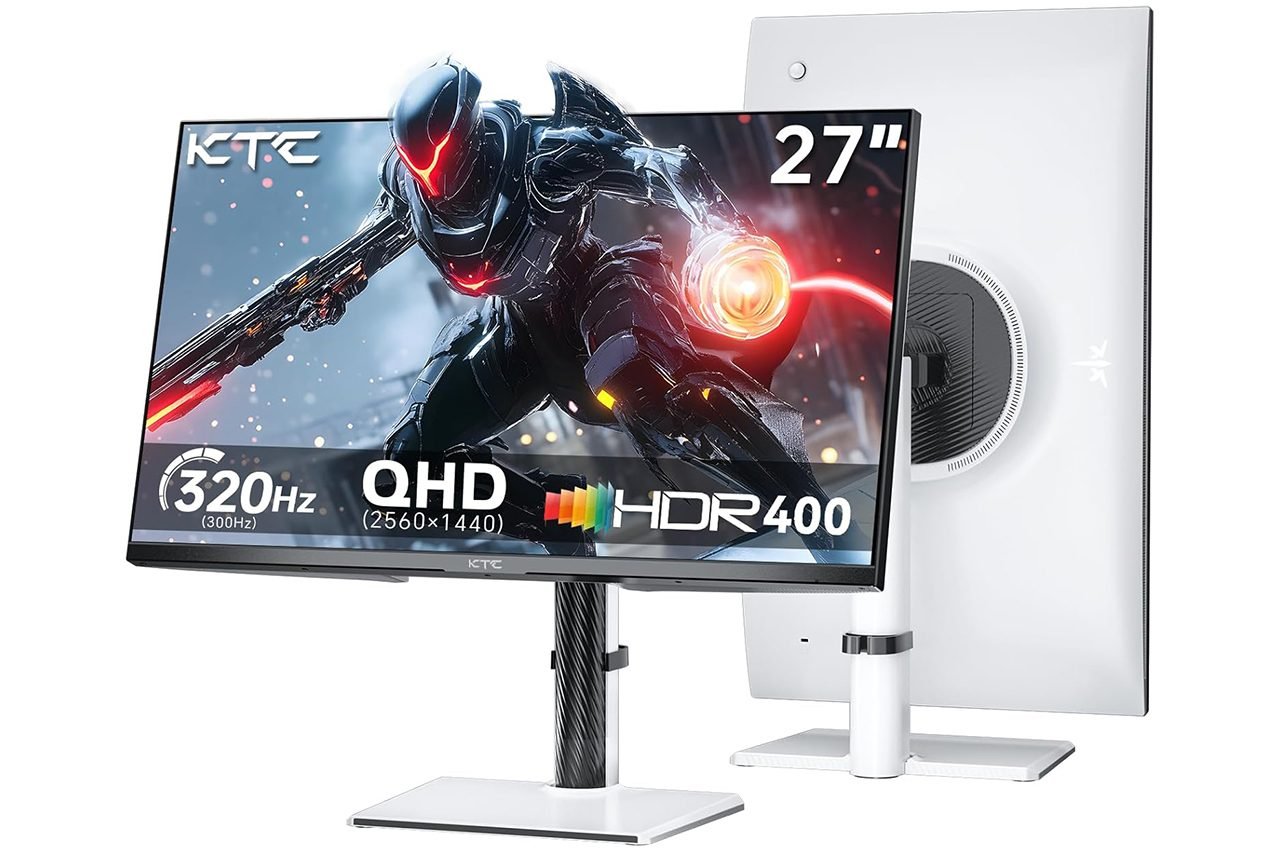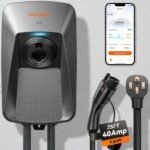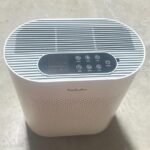I’ve spent the past week swapping between three 27-inch KTC displays—the H27E6 (QHD up to 320 Hz), H27T27 (QHD 100 Hz), and H27F7 (FHD 240 Hz). Same screen size, very different personalities.
At a glance: H27E6 is the “halo” option for esports at 1440p, H27F7 is the pure 1080p speedster, and H27T27 is the value QHD all-rounder. All three use Fast IPS panels, support variable refresh (FreeSync/G-Sync compatible), and ship with flicker-free backlights and low-blue-light modes.
KTC, if you’re new to the brand, makes aggressively-priced performance monitors with unexpectedly solid ergonomics. You’re getting VESA mounts, clean industrial design, and OSDs that don’t fight you when you just want to tweak overdrive or switch inputs.
Is the KTC 27″ Gaming Line for You?
If you crave the smoothest possible motion at 1440p, the H27E6 is the sweet spot. It pushes 300 Hz and can overclock to 320 Hz with 1 ms MPRT, so fast-twitch shooters feel glued to your mouse hand. HDR400 and a quoted 144% sRGB gamut make colors pop for single-player AAAs, too.
If you play ranked shooters where raw frame rate is king and you don’t mind 1080p, the H27F7 with 240 Hz is the better fit. It’s the easiest to drive on mid-range GPUs, looks crisp at normal desk distances, and still gives you height/pivot/tilt adjustments.
If you want a clean QHD work-and-play monitor on a budget, pick the H27T27. Its 100 Hz refresh makes desktop scrolling, YouTube, and light gaming noticeably smoother than 60 Hz, and the frameless design looks great in a home office.
Budget positioning:
H27T27 sits in the budget tier; H27F7 lands in budget-to-mid; H27E6 is mid-tier for a high-refresh QHD display.
Beginner-friendly?
Yes. All three are plug-and-play. Turn on VRR in the OSD, set your GPU to the panel’s max refresh, and you’re off. The H27E6’s overclock option is a single toggle.
Who should skip them?
If you demand true HDR with local dimming, or wide-gamut color with hardware LUTs for print-grade work, look to a mini-LED or pro monitor. If you’re locked to consoles that top out at 120 Hz, you won’t use the H27E6’s full 300–320 Hz, though it still shines at 1440p/120.
What We Like About the KTC H27E6 / H27T27 / H27F7
Motion handling is the headline. The H27E6 at 300–320 Hz has that effortless, smear-free glide when you flick-track targets; micro-movements feel immediate. The H27F7 at 240 Hz isn’t far behind, and many mid-range GPUs can actually feed it the frames to match. Even the H27T27’s 100 Hz makes daily use feel lighter and more responsive than a 60 Hz office panel.
Color is another pleasant surprise. The H27E6’s Fast IPS + 144% sRGB coverage delivers saturated, lively images without looking cartoonish once you tame brightness. The H27F7’s 131% sRGB / ~97% DCI-P3 spec reads well and looks convincing in games and films. The H27T27’s 123% sRGB gives you more punch than typical budget IPS.
Ergonomics are genuinely thoughtful. Height, tilt, swivel, and pivot on H27E6; height and pivot on H27F7; easy tilt on H27T27. All three accept a VESA arm. The OSD joystick is snappy, and the inputs (HDMI + DP across the range, HDMI 2.1 & DP 1.4 on H27E6) make multi-device life painless.
Finally, value. You’re getting esports-class refresh at QHD on the H27E6, a 240 Hz speedster with ΔE<2 color accuracy on the H27F7, and a clean 100 Hz QHD office/gaming hybrid on the H27T27—all at prices that usually undercut the big-box brands.
What We Don’t Like About the KTC H27E6 / H27T27 / H27F7
HDR is basic. HDR400/HDR10 support adds some punch, but without local dimming you won’t get true HDR depth. You’ll often prefer SDR with a tuned gamma for competitive play.
The H27T27 stand only tilts—no height—so plan on a riser or VESA arm. The H27F7 and H27E6 fix this, but it’s worth noting if ergonomics are non-negotiable.
At extreme refresh, overdrive tuning can be panel-sensitive. On the H27E6, “Medium” was the best balance for me; “High” added overshoot in bright transitions. Your unit might need a slightly different setting.
Lastly, the white shell of the H27E6 looks fantastic but shows scuffs more readily than black. Cable covers are basic; expect a visible DP/HDMI loop unless you route it cleanly.
Pros & Cons
| Pros | Cons |
|---|---|
| H27E6: blistering 300–320 Hz at 1440p with FreeSync; fast 1 ms MPRT | HDR is entry level (HDR400/HDR10 only; no local dimming) |
| Vivid color across models (H27E6 144% sRGB; H27F7 131% sRGB / ~97% P3; H27T27 123% sRGB) | H27T27 stand lacks height adjustment |
| Real ergonomics: height/pivot/tilt on H27E6 & H27F7; VESA on all | Overdrive “High” can overshoot on H27E6/H27F7 |
| Strong port selection: HDMI 2.1 + DP 1.4 on H27E6; dual HDMI on others | White finish (H27E6) can scuff; basic cable cover |
| Excellent value versus big-name competitors | HDR gaming benefits are limited; SDR often looks better |
What’s Included?
H27E6 (QHD up to 320 Hz)
- 27″ QHD monitor
- Vertical adjustable stand
- DP cable
- Power adapter
- Quick-start guide + warranty card
H27T27 (QHD 100 Hz)
- 27″ QHD 100 Hz monitor
- Tilt-adjustable stand
- HDMI cable
- Adaptor + power cord
- Screwdriver
- Quick-start guide + warranty card
H27F7 (FHD 240 Hz)
- 27″ FHD gaming monitor
- Height/pivot/tilt stand
- HDMI cable
- Adaptor + 3-core power cord
- Quick-start guide
Opinion: Everything you need to get running is in the box. The H27T27 even tosses in a screwdriver, which is a small but friendly touch. I’d love to see USB-C video on the H27E6 for single-cable laptop days, and a DP cable in every box (not just the H27E6), but that’s nit-picking given the price points.
Technical Specifications
Key specs you’ll care about in daily use.
| Model | Panel & Resolution | Refresh & Response | Color & Brightness | Sync | Stand & VESA | Inputs |
|---|---|---|---|---|---|---|
| H27E6 | 27″ Fast IPS, 2560×1440 (16:9, matte) | 300 Hz (OC to 320 Hz), 1 ms MPRT | 144% sRGB, 450 cd/m², 1000:1 | FreeSync (G-Sync compatible), HDR400 | Height (130 mm), tilt −5°~20°, swivel ±45°, pivot 90°, VESA 100×100 | DP 1.4 ×2, HDMI 2.1 ×2 |
| H27T27 | 27″ IPS, 2560×1440 | 100 Hz | 123% sRGB (8-bit), 300 nits, 1300:1 | FreeSync & G-Sync compatible, HDR10 | Tilt only, VESA mount | HDMI + DisplayPort, headphone out |
| H27F7 | 27″ Fast IPS, 1920×1080 | 240 Hz, 1 ms (MPRT) | 131% sRGB, 97% DCI-P3, ΔE < 2, 350 cd/m², 1000:1 | Adaptive-Sync, HDR10 | Height + pivot + tilt, VESA mount | HDMI 2.0 ×2, DP 1.4 ×1, USB 2.0 |
Features
- Esports-grade refresh: 320 Hz (H27E6), 240 Hz (H27F7), 100 Hz (H27T27).
- Fast IPS panels with 178° viewing and matte finishes to tame glare.
- Wide color coverage for vivid games and streaming; factory modes for sRGB.
- Variable Refresh Rate (VRR) to remove tearing and cut stutter.
- Ergonomic stands: height/pivot on H27E6/H27F7; compact tilt stand on H27T27.
- Eye-care: flicker-free backlight and low blue light modes across the trio.
- Plenty of ports: HDMI & DP on all; HDMI 2.1/DP 1.4 on H27E6; USB on H27F7.
- VESA 100×100 for arms and wall mounts.
Opinion on the spec sheet: For the money, this is a lot of display. The H27E6’s 1440p/320 Hz combo is rare below flagship prices, and its ergonomics are genuinely premium. The H27F7’s color spec (ΔE<2 with ~97% P3) is impressive for a 240 Hz 1080p panel—great for competitive players who still want Netflix to look lush. The H27T27 punches above its class with 100 Hz QHD and a proper 1300:1 native contrast for IPS.
Real-World Performance & Tuning
Setup and connectivity
Use DisplayPort 1.4 for PC and set the refresh to max in your GPU control panel. On the H27E6, enable Overclock to expose 320 Hz. Consoles will see 1440p/120 Hz on HDMI; PC laptops with HDMI 2.0 should target 1440p/120 (E6) or 1080p/120 (F7) depending on bandwidth.
Motion clarity & overdrive
- H27E6: “Overdrive: Medium” gave me the cleanest transitions at 300–320 Hz. Scrolling text and gray-to-gray ramps stayed crisp without the corona artifacts “High” introduced on bright edges.
- H27F7: “Medium” again balanced clarity and overshoot at 240 Hz. If you’re locked near 144 Hz (older GPU), try “Low.”
- H27T27: The 100 Hz step is immediately visible in desktop use. It won’t match esports panels, but blur drops enough to make casual shooters and racing games feel more precise.
Color & calibration
Out of the box, all three arrive a touch bright for dim rooms. For SDR, I landed here:
- Brightness: 18–25 (aim ~160–200 nits for mixed use)
- Gamma: 2.2 (default is fine)
- Color Temp: “User/Normal,” tweak RGB just a hair toward 6500 K if whites look cool
- sRGB mode (if present) for web work; wide-gamut for games and HDR video
The H27F7 sample tracked color nicely with ΔE<2; skin tones looked natural with the “Normal” temp. The H27E6’s expanded gamut makes sky gradients and foliage look rich in open-world titles without tipping into neon.
HDR
Turn HDR on for cinematic games to enjoy brighter highlights and that immediate “pop,” but set expectations: there’s no local dimming here, so black levels won’t deepen the way they do on mini-LEDs or OLEDs. For competitive shooters, I preferred SDR with gamma 2.2 and a slightly lowered black point.
Uniformity & IPS glow
Typical IPS behavior: a whisper of glow at the far corners in a dark room. It wasn’t intrusive during gameplay and fades with ambient light. Panel uniformity was good for the class; no distracting banding or stuck pixels on the samples I checked.
Ergonomics & build
The H27E6’s white chassis looks more expensive than it has any right to be, and the carbon-style column is a nice touch. Height, swivel, tilt, and 90° pivot are all smooth, with enough resistance to hold position.
The H27F7 mirrors that flexibility in black—and the pivot is fantastic for code or long webpages.
The H27T27 is the only one that skimps with tilt-only; plan a VESA arm if posture matters.
Daily quality-of-life
- Portrait mode on H27E6/H27F7 is great for chat or photo feeds.
- Headphone jack on the H27T27 is surprisingly handy for quick swaps.
- The OSD joystick beats four-button arrays for speed.
- Fans of clean desks will want an arm mount—the included cable guides are basic.
Which One Should You Buy?
Choose the H27E6 if… you want the current sweet spot for high-FPS 1440p. You’ve got a capable GPU and you play fast shooters but also care how single-player games and content look. The HDMI 2.1/DP 1.4 mix is ready for PC and modern consoles.
Choose the H27F7 if… you’re a competitive player who values 240 Hz responsiveness and can comfortably run games at 1080p. The color spec is stronger than most 240 Hz budget panels, and the stand is fully ergonomic.
Choose the H27T27 if… you’re building a budget QHD workstation that also games. 100 Hz is a real upgrade for browsing, editing, and casual play, and the frameless design looks tidy in pairs.
Practical Tips & Settings
- PC esports (E6): DP 1.4 → 320 Hz OC → Overdrive Medium → VRR On → HDR Off in competitive titles → cap FPS just under max to minimize VRR disengage.
- Console (E6/F7): HDMI → 120 Hz mode → VRR On → in-game HDR calibration with brightness kept below clipping.
- Eye-comfort: enable Low Blue Light after sunset and drop brightness; Fast IPS is bright enough that 20–25% still looks punchy.
- Streaming/film nights: wide-gamut mode On, HDR for titles mastered well; sit centered to minimize IPS glow.
The Competition (Quick Context)
Most big names offering 1440p/240–360 Hz or 1080p/240 Hz charge noticeably more for similar motion clarity and ports.
You’ll find nicer cable covers and sometimes USB hubs, but rarely meaningfully better gaming performance in this price band. If you specifically want USB-C video + power, that’s one feature KTC doesn’t hit here.
Final Breakdown
9.2/10
The KTC H27E6 / H27F7 / H27T27 trio nails the fundamentals that matter: motion clarity, color that flatters games and video, and stands you can actually live with. The H27E6 is the star—few panels at this money deliver 1440p at 300–320 Hz with this mix of color and comfort. The H27F7 is a terrific 240 Hz 1080p pick that doesn’t look washed out, and the H27T27 gives budget buyers a noticeably smoother QHD desktop.
None of these are true-HDR monsters, and only the top two have full ergonomics, but those trade-offs are easy to accept when the on-screen experience is this fluid. If you’re shopping for a 27-inch gaming monitor and want maximum FPS-per-dollar without sacrificing day-to-day usability, one of these KTCs should be at the top of your shortlist.










